From Postwar to Postmodern Art in Japan 1945ã¢ââ€1989 Primary Documents
Keiji Uematsu (born 1947) is a Japanese contemporary artist and sculptor.
| Keiji Uematsu | |
|---|---|
 2021@Minoo-park. | |
| Born | (1947-03-26) March 26, 1947 Kobe, Nihon |
| Nationality | Japanese |
| Education | Department of Fine Arts, Kobe University |
| Known for | Sculpture, Gimmicky Fine art |
| Notable work | Cutting Centrality-Longitude-Latitude |
| Awards | the 38th Teijiro Nakahara Award, Japan, 2013 |
| Elected | Japan's representative creative person of the 43rd Venice Biennale, 1988 |
Biography [edit]
From boyhood to Univ. [edit]
Keiji Uematsu was born on March 26, 1947 in Kobe, Japan.[1] His father drew illustrations and lettered in the printing factory. His eldest son died soon later on nativity, Keiji was the second son grew upwards watching his task, and the third son Eiji subsequently became an creative person using soil as a textile. Keiji loved painting and making models, and reading the science magazine for the schoolkids also. He became interested in the wonders of science, went often to the museums of the scientific discipline or the natural history. He thought he wanted to grasp the mechanism of the wonder of the earth or the infinite from the primitive perspective. This is related to his afterwards artistic work. His begetter did not allow him to go on to art college, so he entered the art department of the Faculty of Education, Kobe University, graduated in 1969, became a instructor of the arts and crafts at a public school.[2]
Starting time of artist activity [edit]
While teaching at the public elementary school and the technical loftier school, he created his own artworks and presented Transparence - Iron at the 1st Contemporary International Sculpture Exhibition (The Hakone Open-air Museum, Kanagawa, 1969).[2] In the same year he held his first solo exhibition at Galerie 16 in Kyoto, presented Tranceparence - H2O. He besides exhibited at the Kyoto Biennale 1972.
Leap overseas [edit]
He was selected for Japan: Tradition und Genenwart exhibition (Städtische Kunsthalle Düsseldorf, Düsseldorf), sent the work in 1974, October he received the 2nd Kobe City Cultural Encouragement Award.[1] He also appeared in a small role of the famous indie picture I Can't Wait Getting Dark! (directed past Kazuki Ohmori). In September 1975 he went to West Germany for the destination of Düsseldorf, where the activities of artists are agile. From December 1976 to 1977 he held the first solo exhibition in Europe Skulptur, Foto, Video, Film (Moderna Museet Stockholm, Sweden). Since then, he has presented many works at museums and galleries in Europe. His first solo exhibition in Northward.Y. Installation, Axis-Latitude-Longitude was held in 1981 at P.Due south.one (the annex of MoMA). He was invited by Fondation Cartier pour L'Art, and exhibited at Sculptures in Paris from 1985 to 1986 the open up-air work Situation-Triangle for the showtime time in 14 years. Afterwards this he produced many open-air sculptures in Europe, Nippon and Republic of korea.[ii]
Dual base of artist's life [edit]
He established a new base of operations in Nishinomiya, Kobe in March 1986, since and then he continued to work going back and along between West Germany and Japan.[ii] [3] [4] Due to the Slap-up Hanshin-Awaji Earthquake in 1995 he lost Nishinomiya base, moved to Minoo-city of Osaka.[5] He was selected equally a Japanese national artist along with Shigeo Toya and Katsura Funakoshi, for the 43rd Venice Biennale 1988, presented his piece of work Inversion-Vertical space at the Japan Pavilion.[6] [seven] In the 1990s he continued vigorous product activities. His first solo exhibition in a Japanese museum Backside the Perception was held at Otani Memorial Museum, Nishinomiya, 1997.
Activities of the new century [edit]
In 2003 at Kitakyushu Municipal Museum of Art, he was held solo exhibition of photo works mainly Thinking about the Body and Eyes: Photos, Films from the 70'due south to the Present. In 2006 at Otani Memorial Museum, Nishinomiya the exhibition Keiji Uematsu, The Garden of Time was held. Even in the 21st century, he continues to hold solo exhibitions almost twice a year. In 2013, he won the 38th Teijiro Nakahara Award for his work Cutting Axis-Longitude-Breadth. [5]He was selected for Spotlight category of the art fair of London Frieze Masters 2014, presented the 1970'due south photo works and sculputures. In 2016 he exhibited his works at Tate Modern, London Performing for the Camera and solo at Simon Lee Gallery Invisible Forcefulness. In 2021, for the first time in xv years at the Japanese museum he presented the new works Keiji Uematsu: Means of Touching the Invisible - Intuition at Ashiya City Museum of Art and History.
-
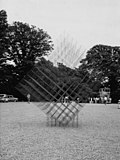
Transparence-Iron, 1969.
-
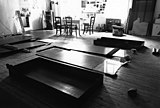
Studio, Düsseldorf, 1977.
-
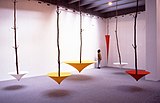
Inversion - Vertical infinite, 1988.
-
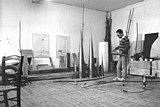
Studio, Düsseldorf, 1991.
-
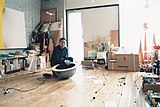
Studio, Minoo, 2006.
-

Cutting Axis-Latitude-Longitude, 2012.
Style and methods [edit]
His works are expressed in a variety of ways, including images (photographs, films, videos), performances (and their image recordings), prints, sculptures, and installations.
The production of the work is called "job (= project)", and the cartoon that describes the thought of the project is also presented as an independent work.[one] [two]
His work of sculpture or installation is a seemingly unstable construction that combines geometric volumes (cones, spirals) of stone, copper, wood, etc. "I desire to express the existence of something invisible, like the universe, with a work in which the entire structure would collapse without 1 element."[1]
Equally materials for sculptures and installation works, cloth, stone, glass, iron, stainless steel, copper, statuary, brass, lumber (mainly Douglas fir), and natural wood in their solid state are oftentimes used.[1]
His mode looks like an abstract, but what is expressed in his work is the embodiment of invisible forces such as gravity.[viii] [9] [ten]
Commencement in 1971, then in 1972, or even in 1991, he wrote: "What I want to do is to make visible existence, visible connections and visible relations appear more clearly. And to cause not-visible existence, non-visible connections and not-visible relations to appear. And to cause visible beingness, visible connections and visible relations not to appear.",[5] "What shall I at present practise with the world (creation) which denies man agreement and where these three relations comprise antinomies? Shall I find a new meaning in the world? How to shape relations betwixt people? These are questions which deeply business concern me."[ane]
These words expresses the basic concept from the earliest days of his creative person'due south activities.[ane] [five] [xi]
Exhibitions [edit]
Select solo exhibitions [edit]
- 1974: Photographs and Films, Gallery Inexpensive Thrills, Helsinki, Finland[1]
- 1975: Galerie St. Petri, Lund, Sweden[one]
- 1976: Photographs and Films, Gallery Inexpensive Thrills, Helsinki, Finland[one]
- 1976: Moderna museet, Stockholm, Sweden[1]
- 1977: Hetzler+Keller gallery, Stuttgart, Germany[i]
- 1977: Situation Interval, New Reform, Aalst, Belgium[ane]
- 1977: Ausschnitte 1, Städtische Kunsthalle Düsseldorf, Germany[1]
- 1979: Installation, Vor Ort Arbeitsgalerie, Hamburg, Federal republic of germany[i]
- 1979: Skulptur, Foto, Heidelberger Kunstverein, Germany[i]
- 1980: Cultuurhuis de Warande, Turnhout, Kingdom of belgium[1]
- 1980: International cultural Eye, Antwerp, Belgium[1]
- 1980: Städtische Galerie im Lenbachhaus+Kunstform, München, Germany[1]
- 1980: Installation Axis-Latitude-Longitude, P.Southward.1, Project Studios 1, New York, Usa[1]
- 1981: Installations and Drawings, Baudoin Lebon, Paris, France[1]
- 1981: Skupturen-Zeichnungen-Fotos, Galerie Löhrl, Mönchengladbach, Germany[one]
- 1982: Cathédrale Saint-Trophime d'Arles, Arles, France[i]
- 1983: Installation, Baudoin Lebon, Paris, France[1]
- 1984: Centrum BeeldendeKunst Rotterdam, The Netherlands[1]
- 1985: Projection - Drawings and Installations, Galerie Löhrl, Mönchengladbach, Frg[1]
- 1986: Installation, Baudoin Lebon, Paris, France[ane]
- 1989: Projection, Kunstraum Neuss, Deutschland[1]
- 1989: Skulpturen und Zeichnungen, Galerie Kiki Maier-Hahn, Düsseldorf, Germany[ane]
- 1989: Skulpturen und Zeichnungen, Galerie Löhrl, Mönchengladbach, Deutschland[one]
- 1989: GeleZaal, Gent, Belgium[one]
- 1990: Sculptures, Waβermann Galerie, München, Deutschland[1]
- 1991: Dortmunder Kunstverein, Germany[1]
- 1991: Waβermann Galerie, Köln, Germany[1]
- 1991: Baudoin Lebon in FIAC, One thousand - Palais, Paris, French republic[1]
- 1992: Baudoin Lebon, Paris, France[v]
- 1992: Ursula Blickle Stiftung, Kraichtal, Federal republic of germany[5]
- 1993: The Animate Space, Waβermann Galerie, München, Germany[5]
- 1993: Skulpturen und Zeichnungen, Galerie Löhrl, Mönchengladbach, Germany[v]
- 1994: It's Possible, Skulpturen und Zeichnungen, Stadtmuseum Siegburg, Deutschland[5] [12]
- 1995: Invisible Structure, Galerie Beatrice Wassermann, München, Germany[five]
- 1997: Behind the Perception, Edwin-Scharff-Haus, Neu-Ulm, Germany[five]
- 2001: Baudoin Lebon, Paris, France[five]
- 2003: Centrality-Breadth-Longitude, Waβermann Galerie, Munchen, Germany[5]
- 2004: Falling Water - Rising Water, Baudoin Lebon, Paris, France[five]
- 2005: Axis-Latitude-Longitude, Kunstlerverein Marlkasten, Düsseldorf, Germany[v]
- 2008: Yearning for What is Floating, Baudoin Lebon, Paris, France[5]
- 2009: Yearning for What is Floating, Le Cafe Francais Art Gallery, Brussels, Belgium[five]
- 2011: Baudoin Lebon (with vladimir skoda), Paris, France[5]
- 2014: Frieze Masters: Spotlight, Regent's Park, London, UK[5]
- 2016: Invisible Force and Seeing, Jacobihaus, Kunstlerverein Malkasten, Düsseldorf, Germany[five]
- 2016: Invisible Force, Simon Lee Gallery, London, Uk[5]
- 2016: Seeing/Measuring/..., Baudoin Lebon, Paris, French republic[five]
- 2018: Invisible Forcefulness, Galerie Löhrl, Mönchengladbach, Germany[five]
- 2019: Keiji Uematsu: Invisible Force, Simon Lee Gallery, New York, Us[5]
Works [edit]
-

Transparence-H2O, 1969.
-

Cutting, 1971.
-

Horizontal position, 1973.
-

Axis-Latitude-Longitude, 1980.
-

Corner slice I - Inversion vertical space, 1988.
-

Situation - Floating space, 1989.
-

Axis-Longitude-Latitude, 1999.
-

Floating form - Scarlet, 2000.
-

With a tree - Touch of Screw, 2003.
-

Touch of Spiral, 2007.
-

In between - grade 2, 2009.
-

Floating form - Invisible centrality, 2015.
-

Cutting triangle, 2017.
-

Floating stone, 2017.
-

Invisible centrality - Horizontal /Vertical inclination, 2019.
-

In between friction - Gift from cosmos, 2021.
-

Invisible force - Centrality-Longitude-Latitude, 2021.
Public collections [edit]
- Wilhelm-Hack-Museum, Germany[i]
- Museum für Kunst und Gewerbe, Hamburg, Frg[ane]
- Kunsthalle Bremen, Germany[1]
- Städtische Galerie im Lenbachhaus, Munich, Frg[1]
- Museum Wiesbaden, Hesse, Germany[1]
- Daimler Art Collection, Berlin, Federal republic of germany[5]
- Cartier Foundation for Contemporary Art, Paris, French republic[1] [9]
- Musée des Arts Décoratifs, Paris, France[5]
- Musée Reattu, Arles, French republic[one]
- Maison Elsa Triolet Aragon, St-Arnoult en Yvelines, French republic[v]
- LA CHAPELLE fine art contemporain, Clairefontaine, France[5]
- Drove Pinault, France[5]
- Moderna Museet, Stockholm, Sweden[1]
- Museum Voorlinden, Wassenaar, The Netherlands[v]
- Bvlgari Collection, N.Y., United states / Rome, Italy[v]
- Museum of Modern Art, New York City, New York, USA[5] [13]
- The Museum of Fine Arts, Houston, USA[5]
Notes [edit]
- ^ a b c d e f one thousand h i j one thousand l grand n o p q r south t u five west x y z aa ab ac advert ae af ag ah ai aj ak al am an ao ap aq 1969-1991 Keiji UEMATSU (Catalog raisonne), 1991.
- ^ a b c d e the Japanese text of interview with Keiji Uematsu, Oral History Archives of Japanese Art; http://www.oralarthistory.org/archives/uematsu_keiji/interview_01.php
- ^ 50 years of galerie 16: 1962-2012 pp.67-74.
- ^ Fotografie in Düsseldorf: dice Szene im Profil, 1991.
- ^ a b c d eastward f g h i j k fifty m n o p q r south t u v westward 10 y z aa ab ac ad ae af ag Keiji Uematsu, Ways of Touching the Invisible - Intuition (catalog of the exhibition), 2021.
- ^ XLIII Esposizione Internazionale d'Arte la Biennale di Venezia, Il Luogo Degli Artisti, General Catalogue 1988.
- ^ The Venice Biennale: forty Years of Japanese Participation, 1995.
- ^ Contemporary Japanese Sculpture, 1991, pp.82-84
- ^ a b La Collection de la Fondation Cartier pour l'art contemporain, 1998.
- ^ Dictionnaire Bénézit, Dictionnaire des peintres,sculpteurs, dessinateurs et graveurs, vol. thirteen, 1999, p. 892.
- ^ Von der Natur in der Kunst, Eine Ausstellung der Wiener Festwochen, 1990.
- ^ It's Possible, Skulpturen und Zeichnungen, 1994.
- ^ "Keiji Uematsu". The Museum of Modern Art (MoMA) . Retrieved 2021-11-16 .
{{cite web}}: CS1 maint: url-status (link)
References [edit]
Books and Catalogs [edit]
- Keiji Uematsu: Skulptur Foto Video Flick. Sweden: Moderna Museet. 1976. ISBN91-7100-112-iii.
- Gottfried Jäger (1988). Fotografik - Lichtgrafik - Lichtmalerei, Bildgebende Fotografie Ursprünge, Konzepte und Spezifika einer Kunstform (in German). DuMont Buchverlag Köln. ISBNiii-7701-1860-10.
- Edizioni La Biennale Realizzazione Fabbri Editori (1988). XLIII Esposizione Internazionale d'Arte la Biennale di Venezia, Il Luogo Degli Artisti, Genaral Catalogue 1988. ISBN88-208-0346-1.
- Wiener Festwochen, Künstlern, Leihgebern und Autoren (1990). Von der Natur in der Kunst, Eine Ausstellung der Wiener Festwochen (in German). ISBN3-901027-01-7.
{{cite book}}: CS1 maint: multiple names: authors list (link) - Helga Meister (1991). Fotografie in Düsseldorf: dice Szene im Profil (in German). Schwann im Patmos-Verlag. ISBN3-491-34227-9.
- 1969-1991 Keiji UEMATSU (in Japanese, English, German, and French). Nomart Editions. 1991. ISBN4-931270-03-four.
- Janet Koplos (1991). Contemporary Japanese Sculpture. Abbeville mod fine art movements. ISBN1-55859-012-nine.
- Keiji Uematsu: It's Possible, Skulpturen und Zeichnungen. Stadtmuseum Siegbulg. 1994. ISBNiii-925551-75-1.
- The Venice Biennale: 40 Years of Japanese Participation. 1995. ISBN4-620-80314-six.
- Fondation Cartier pour l'fine art contemprain (1998). La Collection de la Fondation Cartier pour l'art contemporain. Actes Sud. ISBNii-7427-1577-0.
- éditions Gründ (1999). Dictionnaire Bénézit: Dictionnaire des peintres, sculpteurs, dessinateurs et graveurs vol. 13 (in French). ISBN2700030230.
- From Postwar to Postmodern, Art in Japan 1945-1989: Primary Documents. MoMA. 2012. ISBN978-0-8223-5368-three.
- 50 years of galerie 16: 1962-2012. Kyoto: galerie 16. 2014.
- Keiji Uematsu, Ways of Touching the Invisible - Intuition. Ashiya Metropolis Museum of Art and History. 2021.
Web [edit]
- Oral History Archives of Japanese Art (2018-05-25). "Interview with Keiji Uematsu".
Source: https://en.wikipedia.org/wiki/Keiji_Uematsu
0 Response to "From Postwar to Postmodern Art in Japan 1945ã¢ââ€1989 Primary Documents"
Postar um comentário